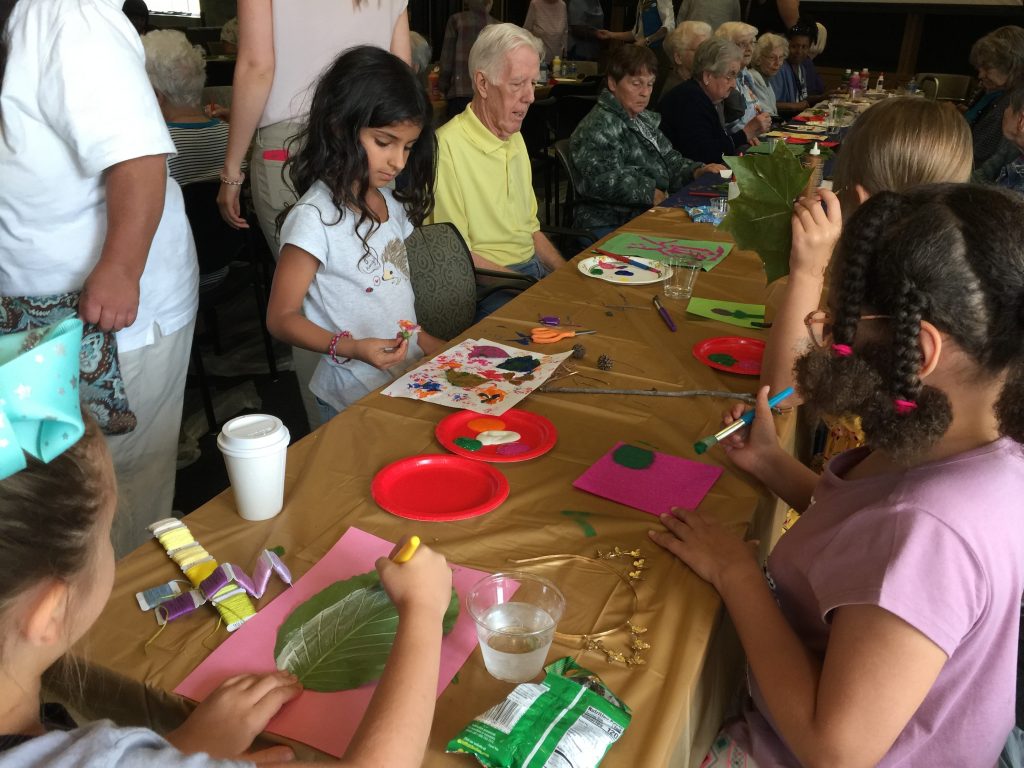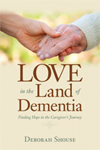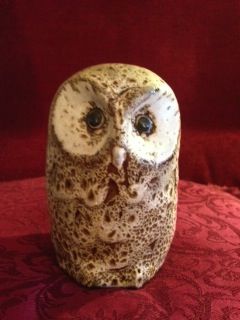Posts Tagged ‘nature’
Using Nature to Connect with Creativity and Generations: KC Memory Cafe
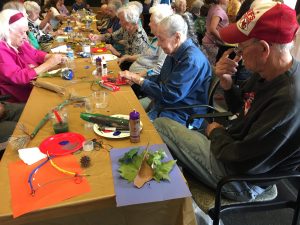 The tables are scattered with pine cones, sycamore leaves, and decorative branches, along with bottles of glue, vivid construction paper, and pots of colorful paint. Our KC Memory Cafe begins with sharing memories of camping, scouting, or outdoor activities. Then a lively group of Girl Scouts leads us in song, reminding us to, “Make new friends, But keep the old, One is silver, And the other gold.”
The tables are scattered with pine cones, sycamore leaves, and decorative branches, along with bottles of glue, vivid construction paper, and pots of colorful paint. Our KC Memory Cafe begins with sharing memories of camping, scouting, or outdoor activities. Then a lively group of Girl Scouts leads us in song, reminding us to, “Make new friends, But keep the old, One is silver, And the other gold.”
After our singalong, cafe guests experiment with the art supplies and natural 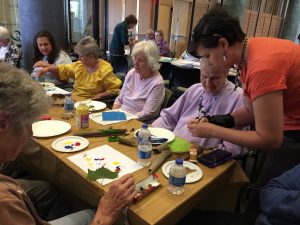 objects. They dip pine cones into red paint and brush blue across crusty leaves. They paint a stick bright orange and wrap it with yarn. The Girl Scouts weave through the artists, pouring extra paint, distributing additional papers, and assisting when asked. The guests work, admire, chat, and laugh as these creative projects emerge. By the end of the cafe, the tables are covered with innovative art and people are smiling as they return home.
objects. They dip pine cones into red paint and brush blue across crusty leaves. They paint a stick bright orange and wrap it with yarn. The Girl Scouts weave through the artists, pouring extra paint, distributing additional papers, and assisting when asked. The guests work, admire, chat, and laugh as these creative projects emerge. By the end of the cafe, the tables are covered with innovative art and people are smiling as they return home.
Click here for a look at our cafe.
Want to introduce more nature into your lives?
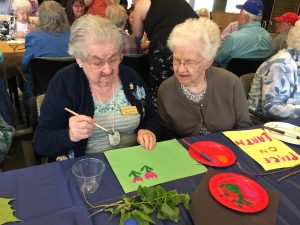 “Research shows that nature-based activity is therapeutic and is essentially a form of treatment for dementia symptoms, helping a person remain at home longer,” says Garuth Chalfont PhD, American Society of Landscape Architects, and author of the. Dementia Green Care Handbook.
“Research shows that nature-based activity is therapeutic and is essentially a form of treatment for dementia symptoms, helping a person remain at home longer,” says Garuth Chalfont PhD, American Society of Landscape Architects, and author of the. Dementia Green Care Handbook.
Gathering flowers, walking a tree-lined sidewalk, plucking a cherry tomato off its vine, watering a house plant, gazing out the window at chickadees—these meaningful natural activities increase pleasure, relaxation, social interactions, and sensory stimulation.
Here are a few other ideas:
• Create observation spots in your living space so you can enjoy looking outdoors. Even watching the weather helps people feel engaged in the natural environment.
• Improve your view with interesting additions, such as bird feeders and birdhouses, bubbling fountains, wind chimes, wind spinners, outdoor sculpture, and various plants and herbs.
• Add resilient plants to your home. 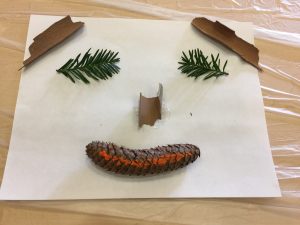
• Bring in natural objects to touch, identify, arrange, draw and craft with.
• Visit garden centers, parks, playgrounds, and zoos for a rich natural experience.
• Increase your popularity by taking a dog with you on a walk, either your own or borrow your neighbor’s pup.
Click to view informative and inspiring short videos on our YouTube channel
Deborah Shouse is the author of Connecting in the Land of Dementia: Creative Activities to Explore Together and Love in the Land of Dementia: Finding Hope in the Caregiver’s Journey.
Creating Low-Cost, Engaging Activities
Creating Low-Cost, Engaging Activities
 Alice looks blankly at the magazine as Kimberly Clark turns the pages, pointing to various pictures. “What do you think of this? Or this?” she asks, pointing to a rose, a table set for tea, a bundt cake. When Kimberly touches a picture of a train, Alice smiles. Although Alice, who is living with dementia, can no longer tell her own stories, Kimberly has heard tales of her adventurous past. When Alice was a restless young woman, she and her new husband occasionally jumped on a freight train and took a ride. This photo will be the centerpiece of the collage they are making. As Program Coordinator at ARC Jackson County, a lifespan respite program in Medford, Oregon, Kimberly is an expert at creating low-cost, engaging activities for people who are living with dementia.
Alice looks blankly at the magazine as Kimberly Clark turns the pages, pointing to various pictures. “What do you think of this? Or this?” she asks, pointing to a rose, a table set for tea, a bundt cake. When Kimberly touches a picture of a train, Alice smiles. Although Alice, who is living with dementia, can no longer tell her own stories, Kimberly has heard tales of her adventurous past. When Alice was a restless young woman, she and her new husband occasionally jumped on a freight train and took a ride. This photo will be the centerpiece of the collage they are making. As Program Coordinator at ARC Jackson County, a lifespan respite program in Medford, Oregon, Kimberly is an expert at creating low-cost, engaging activities for people who are living with dementia.
Creating collages is easy, inexpensive, and relaxing. Medical offices will donate their old magazines and she also collects periodicals from friends. If Kimberly knows her client’s family stories, she seeks magazines that have illustrations relevant to them. She lays out a variety of magazines and asks, “Which one do you want to look at first?” They sit together and Kimberly slowly turns pages, listening for comments, watching body language, and facial expressions. When she sees interest or excitement, she may ask, “What are you looking at?” or “What does this remind you of?” She then tears out the picture and sets it aside, so it’s not distracting. Once they have a nice group of photos, they start on the collage, cutting and pasting together.
“The project is empowering and can spark discussion,” Kimberly says. “Plus, we can take our time and we have something artistic and interesting to discuss when it’s done.”
She often uses the finished collage again and again as a conversation starter.
Kimberly also engages people through simple nature walks, where they notice the colors, shapes, wildlife, and collect vibrantly colored leaves, pinecones, acorns, and more.
She celebrates people’s individuality by writing their name on watercolor paper in black marker and inviting them to fill in the letters and surroundings with colored pencils.
When people need a little exercise and a good laugh, she invites her dog to join them in a sparkling game of balloon volleyball. Her dog is an expert at keeping the balloon aloft and soon everyone is supporting him in this uplifting endeavor.
“Even if you’re not in a good mood, doing some kind of art, exercise, or creative project makes you stop and appreciate the present,” Kimberly says.

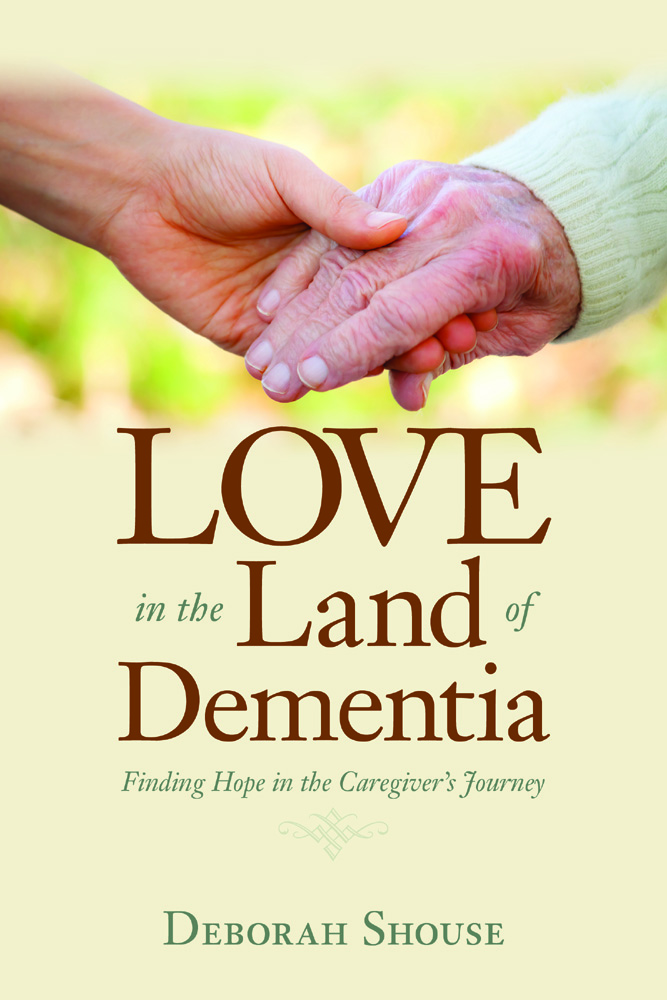
Boost Body and Spirit with Nature: Tips for Care Partners and People Living with Dementia
“I can’t imagine a world where I couldn’t enjoy outdoor pleasures whenever I want,” said Mike Good, founder of Together in This. As I listened to Mike’s Podcast on the power of nature, I thought of my mother. Mom taught me to love birds, flowers, trees, and mountains. Even in her last days, a yellow rose could catch her attention, inspire her to reach out and touch its tender petals. This simple activity helped boost body and spirit with nature.
There’s increasing research that backs up what I observed with my mom. Strolling or wheeling around a courtyard, sitting on a bench underneath an apple tree, observing a bunny nibble clover, watching someone water a tomato plant — all these outdoor events enhance physical and mental well-being, including improving sleep cycles and reducing agitation.
Garuth Chalfont, PhD, American Society of Landscape Architects, and author of the book, Dementia Green Care, says, “Nature-oriented activities, such as growing and caring for plants, promote brain neuroplasticity and help us dream, experiment, learn and create. Research shows that nature-based activity is therapeutic and is essentially a form of treatment for dementia symptoms, helping a person remain at home longer.” Garuth is internationally known for his work in designing, building, and researching gardens that benefit people with dementia.
Mike Good says, “The feel of sunshine on my face, the smell of flowers blooming, the sounds of kids frolicking in the park — while these pleasures naturally occur for most of us, millions of people who are living with dementia find themselves unable to enjoy such routine pleasures without assistance”
Taking a loved one who is living with dementia outdoors can be stressful, but staying cooped up inside is hard on both of you. Here is a bouquet of nature’s benefits, inspiring for both people who are living with dementia and those who care for them.
Relaxing outdoor activities
Gardening activities, such as container gardening, planting seeds, watering, weeding, harvesting, sharing flowers and fruits and vegetables
Walking around the yard or strolling through the neighborhood
Discussing people and dogs walking by, asking open-ended questions, such as “Where do you think they’re going?”
Installing a small fountain and a bench, then sitting and enjoying the sound of the water
Sharing a picnic lunch
Drawing or painting outdoors
For those who enjoy projects, have tools visible and available. For a woodworker, set out wood and sandpaper. For a frail gardener, have a container of herbs. For those who like to tidy the yard, offer gardening gloves and a bucket to deposit leaves and twigs.
Bringing Nature Indoors
Garuth says, “If going outdoors is not feasible, look around your living quarters and ask, ‘Where are the best outdoor views? Where is the most sunlight?’ You may need to cut down a light-blocking bush or move a sofa, but you will discover areas where you and your partner can enjoy sitting and watching nature.”
Open the curtains and blinds to let in light.
In temperate weather, open windows and welcome fresh air and birdsong.
Green up the room with houseplants.
Bring in flowers or herbs to stimulate the senses.
Create a comfortable viewing area, with feeders, so you can enjoy watching birds and squirrels.
Gather potting soil, water, and green bean seeds. Spoon the soil into small pots or into an empty egg carton. Place one seed in each and cover with soil, then pour in a little water.
“Touching soil and planting may trigger memories and ideas from earlier years,” Garuth says.
Gathering flowers, walking a tree-lined sidewalk, plucking a cherry tomato off its vine, watering a house plant, gazing out the window at chickadees — these meaningful natural activities increase pleasure, relaxation, social interactions, and sensory stimulation.
For more information about Mike Good and his work, visit http://togetherinthis.com/ and view his nature video at https://www.youtube.com/watch?v=P7KWaSUHVQo
To learn more about Garuth’s work, visit http://www.chalfontdesign.com/ and http://www.chalfontdesign.com/lifework.html
Deborah Shouse is the author of Connecting in the Land of Dementia: Creative Activities to Explore Together and Love in the Land of Dementia: Finding Hope in the Caregiver’s Journey.
Four Fine Ways to Keep Remembrances Blooming
How do you celebrate Mother’s Day or Father’s Day when your parents are no longer living? As the day approaches, I think of my parents and look for ways to keep remembrances blooming. During the years, I’ve explored ways to feel close with my mother, father, and other loved ones who have passed on. Here are four of the actions that keep me connected.
Dress to Connect
When I feel lonely for Mom, I like to put on her black blouse emblazoned with silver sequins. When Mom wore this blouse, it signified she was going someplace elegant. She accompanied it with a long black skirt and high heels. When I put on my ordinary black slacks and black tennis shoes, I imagine my mother shaking her head. “Don’t you have any better shoes, dear?” My mother prods me from beyond the grave, intoning, “A little lipstick would be nice.” Here’s the lovely part of our post-death ritual: instead of bristling at her grooming suggestions, I see how she wished the best for me and fondly remember her love of dressing up.
Feed your Memories
I still love to eat and share my parents’ favorite foods. My brother, who has untold culinary abilities, has mastered Mom’s butterscotch brownies and he has improved on her chocolate chip cookie recipe. He often bakes those for family gatherings and sometimes even mails me a box of nostalgic homemade treats. As for my dad, he particularly liked Planter’s Deluxe Nut Mix. He adored the cashews, but he didn’t want to spend the money to upgrade to all cashews. He preferred to pick out the deliciously rare morsels, leaving behind a plethora of peanuts, almonds, and hazelnuts. In his honor, I often buy a can of mixed nuts. Did you know that memorial cashews have no calories?
Tell their Stories
We all have heirloom family stories that anchor us in our history. My father liked to talk about his growing up days in the Canal Zone, in Colon, Panama. My mother favored her time serving as an Army nurse in Iceland during World War II. These were the stories of my growing up years and I think of them every time someone talks about Iceland, Panama, the Canal, or WWII. I have written some of them down so I won’t forget them. When I tell one of my parents’ stories, I feel they are in the room, leaning forward, smiling, and listening with delight. I like to share these tales at family gatherings and I like to tell them to friends. I also like to invite other people’s legendary stories.
Continue the Conversation
Sometimes I go on a solitary walk and talk to my mother. She loved birds and I point out the robins, cardinals, and sparrows on the route. I also tell her about my grandchildren, my work, and I discuss any dilemmas I’m struggling with. My father loved being in the water and I often commune with Dad when I’m swimming backstroke. I tell him entertaining things that are going on and talk to him about my dreams and big ideas. My parents are still good listeners and I picture them nodding proudly and cheering me on.
A version of this article originally appeared on MariaShriver.com
Deborah Shouse is the author of Connecting in the Land of Dementia: Creative Activities to Explore Together and Love in the Land of Dementia: Finding Hope in the Caregiver’s Journey.
A Unique Opportunity to Learn from Creative Pioneers
I just received this webinar invitation from Garuth Chalfont, who is a pioneer in using nature with those who are living with dementia. I interviewed Garuth for my upcoming book and he is filled with great ideas. I am going to attend his free webinar and I thought it could be of interest to you. Please feel free to share this with others. It’s a unique opportunity to learn from innovators in this creative field.
www.lancaster.ac.uk/fhm/research/centre-for-ageing-research/#newsampevents Click on the link and simply scroll down to “Non-drug Treatments to Intervene and Prevent Dementia.” To register, email Jan and she will put you on the list.
Meanwhile, these tips from Garuth are featured in Connecting in the Land of Dementia: Creative Activities to Explore Together, which comes out in September.
“Research shows that nature-based activity is therapeutic and is essentially a form of treatment for dementia symptoms, helping a person remain at home longer,” says Garuth Chalfont PhD, American Society of Landscape Architects, and author of the Dementia Green Care Handbook. (You can download this book for free by going to Garuth’s website: www.chalfontdesign.com/ Garuth is internationally known for his work in designing, building and researching gardens that benefit people with dementia. He also partners with care facilities and families, helping them integrate nature into their living quarters and their outdoors.
Gathering flowers, walking a tree-lined sidewalk, plucking a cherry tomato off its vine, watering a house plant, gazing out the window at chickadees—these meaningful natural activities increase pleasure, relaxation, social interactions, and sensory stimulation.
“Enjoying the garden goes beyond just walking around,” Garuth says.
Imagine you’re hosting a guided tour of your yard. What is the most thrilling part of your lawn? A blooming rose bush? A bird bath? A wise old fir tree?
“By creating a tour, you’re taking a new look at your environment. You’re telling a story and engaging your partner,” Garuth says.
Stir up conversation by focusing on one area at a time. Perhaps discuss the hanging bird feeder. Or a seashell you two found on your last vacation. Then observe the birdbath or other water feature. Do you have a bench? Sit down and talk about what you see. Create a wow ending with something that is fun and dramatic, such as a ceramic gnome peeking from behind a rock. Seeing your yard as a living story may inspire you to add in a playful spinner, a cute stone animal, or a beautiful rock.
Deborah Shouse is the author of Love in the Land of Dementia: Finding Hope in the Caregiver’s Journey.
COMING SOON: CONNECTING IN THE LAND OF DEMENTIA: CREATIVE ACTIVITIES TO EXPLORE TOGETHER
Three Star-Studded Tips: The Creativity of Being a Care Partner
“For my part I know nothing with any certainty, but the sight of the stars makes me dream.” Vincent Van Gogh
Several years ago, we spent an evening in Zion National Park in Utah looking for shooting stars.
“There’s one,” someone said.
“I see it!” someone else said.
I saw only the regular stars, which were also gorgeous but not quite as exciting.
“I can’t see any shooting stars,” I finally confessed.
“Here’s how you spot a shooting star,” our friend Ron told me. “You soften and widen your gaze and stare off into the middle distance. You’re looking at everything and nothing. That way you’re open to that sudden flash of light and movement.”
I didn’t see the flash of light from a shooting star that evening, but I did have an idea flash. Looking for shooting stars is like inviting out creativity. You open up your focus, relax, put yourself in receiving, daydreaming mode and wait for something marvelous.
For me, the art of being a care partner was an exceedingly creative endeavor. Much of the time was fraught with focus, dedicated to detail. But when I remembered to soften and widen my gaze, I was able to see my mom for the star she was, even when she seemed light years away from me.
Here are some tips for your own personal “star-gazing:”
Sit quietly with the person living with dementia. If appropriate, hold hands.
Let go of your history and your expectations. Appreciate her just as she is.
Open your mind and heart: be receptive to whatever flashes of light may come your way. Be happy even if you think nothing particular has happened.
For me, this was a rich way to connect with Mom when she was without words. Just sitting still renewed me, and ideas and memories often bubbled up.
Deborah Shouse is the author of Love in the Land of Dementia: Finding Hope in the Caregiver’s Journey.
A Caregiver’s Gift from Her Mother
Recently, I met Cynthia and her mother, Frances. I was so inspired by their story and I wanted to share it with you.
**
Some people steal away to a day spa so they can slow down and relax. Others take a vacation or immerse themselves in a meditation retreat. Cynthia Robinson, age 61, didn’t have time for any of those options. It was 2010, and as she was trying to build her consulting practice, she realized her 88-year-old mother, who lived alone, had memory problems. When Cynthia took her mother to a neurologist, the diagnosis was mild cognitive impairment, which for many is a precursor to Alzheimer’s.
Cynthia was thrust into the role of primary caregiver.
“Initially, I felt irritated and a little resentful,” she said. “I loved my mother but I didn’t want caring for her to take up so much of my time.”
Deciding What Was Most Important In Life
Cynthia had to decide what was most important. Was it taking care of her mother or building her business? She analyzed her situation; her husband was retired and they could get by on his income.
“I knew I would regret it if I didn’t take care of Mom,” she said. She had another reason: she felt she could be at risk for Alzheimer’s. “I wanted to model caring behavior so my daughters and husband would know how to act if I ever developed this disease,” she said.
Cynthia wanted to think of ways her mom could feel valuable and really loved and she experimented with these concepts:
Slow Down
She slowed down to her mother’s pace. She didn’t bring her computer over to her mom’s house; she didn’t talk on her cell phone or check her emails and texts. “I tried to patiently experience my mom’s world,” she said.
Listen Lovingly and Learn
Even though she sometimes bit her lip in frustration as her mom endlessly repeated the same story, Cynthia practiced really listening to her mom’s tales.
“Once I did this, I heard stories I’d never heard before,” she said. “ I learned some meaningful family history.”
Experience the Sensory Beauty of the Present
“I had never paid attention to the millions of shades of bright green,” Cynthia said. “But Mom notices sensory things and we talk about the colors, the flowers and the trees. She keeps me in the here and now.”
Seek Interesting Solutions
Normally, Cynthia’s mom would never wear a hat. But her long hair was thinning and Cynthia bought her a cute cap. Her mom was delighted by the gift and whenever she wore it, she received compliments.
Find New Common Ground
Cynthia installed birdfeeders at her mom’s house. Enjoying the ever-changing array of birds increased her mom’s quality of life and gave them a new topic of conversation.
Delighting in Her Mother’s Gifts
The more Cynthia slowed down and stayed in the present with her mom, the more she appreciated her mother’s wisdom and serenity. Her mother repeatedly told her, “People are about as cheerful as they make up their minds to be.”
“ My mother once guided me through the experience of being a parent,” Cynthia said. “Now, she’s guiding me in the experience of how to make the best of Alzheimer’s.”
**Who are your unexpected guides? What fascinating lessons are you learning on your journey?
Admiring the Plastic Frogs: A Tool for Creatively Navigating the Caregiver’s Journey
“There’s the frog. There’s the ladybug.” My two year old grandson Robert is pointing excitedly to a green plastic frog poised to devour a plastic ladybug. The sun illuminates the spider web that stretches across my neighbor’s small front yard pond and waterfall, a fasicinating place that Robert avidly visits every time he comes over.
Robert never tires of discussing the various frogs, lizards, giant ants, snakes and butterflies that our neighbor has carefully placed around his pond’s perimeter. We count the lizards and marvel at the new scary black spider. We notice the bubbles as the water cascades down its rocky slope and we marvel at the large frog that’s taking a shower. One miniature yellow frog perches across the pond on a flat rock while a turtle bathes serenely several rocks up.
Although they are seemingly inanimate objects, under Robert’s vivid scrutiny they come to life. Each time, we notice something different and we admire something familiar. Each time Robert visits, I can’t wait to go to the waterfall with him.
Noticing Can Lead to Understanding
Robert intuitively knows something that I had to struggle to learn: just noticing and speaking aloud the details can lead to understanding and admiration.
One summer, Ron and I went on a spiritual retreat and the teacher gave us this exercise. “Go on a noticing walk,” he told us. “Take turns simply reporting out loud on what you see.”
At first, it seemed silly and awkward to say, “I see a red barn,” or “I see a mica rock.” But after about ten minutes, our noticing became more natural. As we reported the sights, the intricacy and important importance of each object seemed to sink into us. We walked more slowly, eager to appreciate our environment.
Using Awareness on the Caregiver’s Journey
Years later, when my mother was deep into Alzheimer’s, I remembered that walking exercise and decided to use it on a visit to her.
At first, I felt an emotional charge as I walked up to the Memory Care Unit and “noticed” the keypad that let me into the area, a keypad that symbolized the locked unit, the loss of freedom, the decline of my mother. I had to take a breath and remind myself, “This exercise isn’t about symbology; this is simply an observational experience.”
My mom was asleep when I reached her room and I sat down and began quietly looking at her. I noticed her silver curly hair. “I see pink fingernails,” I murmured. “I see a woman wearing a navy blue sweatshirt.” I slowed myself down and noted the details of the room, each one interesting in its own right. By the time my mother stretched and awakened, I was right there, grounded by the simple act of noticing, ready to look into her eyes and meet her wherever she was. The awareness exercise had slowed me down and opened me up.
Take Ten and Appreciate
What can you more deeply appreciate through noticing? It’s fun to take ten minutes and just report to yourself on the objects around you. It’s even more fun to do this with someone. And if you’re lucky enough to have a child and a pond, get ready for a delightful experience.
Noticing The Perfect Moment: Adding Joy to the Caregiver’s Journey
One Friday in August, I looked out our kitchen window and saw something I had always wanted to see: a Barred Owl.
All my life, I had admired owls in zoos and animal parks but I had never seen one in nature. This bird was resting on a branch of our giant oak tree only 15 feet away from me. I stared in awe as he lifted his claw and scratched the side of his face, then swiveled his head from side to side and ruffled his feathers. I ran upstairs to get my partner Ron and together we watched the owl like he was an award-winning documentary.
“I have to get back to work,” I told Ron and he nodded. We both returned to our home offices but it was hard to concentrate knowing such a powerful bird was nearby. We looked up owls on-line and learned they represent wisdom, intuition, and magic. One person wrote, “Owls give us the power to see that which is hidden to the naked eye.”
Drinking in Every Movement
Already, we were under the animal’s charismatic magic spell. Every 15 minutes I took a break to commune with the bird. Once a butterfly fluttered around the owl’s head and the owl followed its movements like a child would watch soap bubbles. Every movement was interesting to me. The owl slept; with its great eyes hooded its face seemed empty. Upon awakening, it stretched its wondrous wings (a wing-span of almost four feet, our bird book reported) and preened. I gazed at the owl and the owl stared at me as if looking deep inside my soul.
During the course of the day, several friends and neighbors came over to view the winged visitor. They were as excited, mystified and awestruck as we were.
As I marveled at the beautiful brown and white patterning on the owl’s chest, I remembered my first glimpse of such a creature: at a pottery store in Pigeon Forge, Tennessee. I was 14 when my family vacationed at a friend’s cabin in the Smoky Mountains. One day we went into town, ate at a fried chicken restaurant and toured the pottery factory. My brother and I were each allowed to select one item from the seconds’ table and I chose a small Barred Owl. I loved the whimsical, serene and profound look on the figurine’s face. Though I had saved very few things from my childhood that souvenir was still with me. Miraculously, I knew right where it was. I walked into the living room and took the small clay object off the mantel. I held it in both hands and closed my eyes, hoping for a profound insight or mystical moment.
None came; just the special joy I always feel in the presence of birds.
Appreciating the Beginning and the Ending
That evening, before we went out to meet friends, Ron and I peered through the kitchen window and said goodbye to our owl.
“We hope we see you tomorrow,” we said.
Early the next morning, I ran breathlessly to the kitchen. The tree was empty; the owl was gone. My sense of loss was quickly replaced by a feeling of gratitude. We had experienced the miracle of winged wisdom and I knew that owl would be with me for a long, long time.
The Daily Challenge For Caregivers and All of Us: Finding the Moments
That Friday it was easy to notice the perfect moments. Other days, it’s more complicated. Part of my creative challenge to myself is to notice the magic in every day, even a day that’s prone to mundanity or challenges.
How about you? How do you notice the gifts in each day? What are some of your perfect moments?
